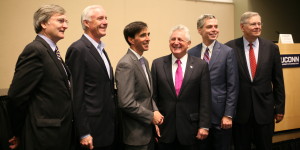One of the key ingredients to restoring a city”™s urban center is improving its transit system. Another is creating affordable housing. That was the consensus of five mayors from Fairfield and Westchester counties who recently shared how they are leveraging their respective cities”™ strengths to grow their urban cores.
The “Meet the Mayors” event, which was held at the University of Connecticut in Stamford, drew architects, developers and commissioners from across the region as mayors from Norwalk, Stamford and Bridgeport in Fairfield County joined mayors from White Plains and New Rochelle in Westchester County to discussed their cities”™ respective strengths and weaknesses.
The event was moderated by Joseph J. McGee, vice president of public policy and programs at The Business Council of Fairfield County. The lead sponsor of the conference was People”™s United Bank.

- From left, Joseph J. McGee, vice president of public policy and programs at The Business Council of Fairfield County; Bridgeport Mayor Bill Finch; New Rochelle Mayor Noam Bramson; Norwalk Mayor Harry Rilling; White Plains Mayor Thomas Roach; and Stamford Mayor David Martin. Photo by Crystal Kang
All the mayors agreed that improving their transportation systems was critical to the resurgence of the urban centers. White Plains Mayor Thomas Roach said he is seeing young people using fewer cars as they move to the city”™s downtown and create a stable financial base for businesses to draw upon.
Roach said the keys to economic success in White Plains are its two Metro-North Railroad stations and Bee-Line Bus service.
Bridgeport Mayor Bill Finch said he believes transportation is worth the investment. His city is planning to build a second train station on a vacant 700-acre property. Finch said the city is transforming its vacant properties into clean-energy parks to attract more jobs.
Stamford Mayor David Martin said the challenge for Metro-North is that its outbound trains outnumber its inbound trains, causing an imbalance in train frequency.
The Metropolitan Transportation Authority addressed the issue of congested tracks through a recently approved $32 billion, four-year capital improvement plan to add more train stations in the Bronx and possibly a new commuter line into Manhattan”™s Penn Station. Yet Martin said the MTA shouldn”™t use the money for new tracks but rather to improve its existing tracks. The reason trains take longer on the New Haven Line is because the tracks are too close together, he said, causing trains to operate slower to prevent them from clipping trains on neighboring tracks.
“The highest concentration for rail traffic in America is Metro-North,” Martin said. “Give us $5 billion, and we”™ll have tenfold improvements in terms of train times from New Haven down to New York using the existing railroads.”
As mayors notice that their downtowns are evolving, they said it”™s important to incorporate affordable housing. Norwalk Mayor Harry Rilling said with the resurgence of its urban core, the city, which has 87,000 residents, is moving forward with market rate developments that include affordable housing units.
“We have a 10 percent requirement if you”™re going to build over 20 units,” Rilling said, “That”™s working very well because people will be able to work where they live instead of having to drive 10 to 12 miles to get to work.”
Affordable housing is not the only driving force behind diversity. New Rochelle Mayor Noam Bramson said, “As by necessity or desire, and as people try to move toward a more green lifestyle, the cities are going to become increasingly attractive.”
The mayors agreed that they can only move as quickly as the state and federal governments move and that partnerships are important to making progress.
“What you”™re seeing is people are going faster than governments,” Finch said. “The types of governments that can go the fastest are mayors. It”™s the combination of the city government and the business council working together that helps create jobs.”

















Crystal – just for record, the Meet the Mayors event was a program developed and co-sponsored by the University of Hartford Construction Institute – Fairfield County Council and the SMPS-NY Westchester Chapter.